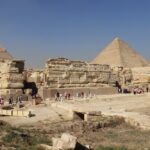and the reason why experts in archaeology maintain that Egyptians built them
Written by Egyptologist Yasser Abdelghanni
.The subject of constructing the Pyramids in Egypt is a fascinating and contentious matter within the realm of Egyptology. Numerous visitors who come to see the Great Pyramids of Giza frequently ponder over the methods employed to erect these colossal edifices. Scholars hold varying viewpoints regarding the process of building these architectural marvels.
Scholars have determined that the pyramids were built by utilizing sizable limestone blocks that were extracted from nearby quarries using copper tools. These quarries are still visible today, situated adjacent to each of the three primary pyramids on the Giza plateau. Visitors have the opportunity to witness the quarried blocks, which display chisel marks, serving as tangible proof that the ancient Egyptians employed copper chisels, wooden shims, and hammers in their construction endeavors.
In 2013, Pierre Tallet, a renowned French Egyptologist, made a significant breakthrough that brought fresh insights into the building of the Great Pyramid. His discovery involved a set of ancient papyri authored by an inspector who resided during the reign of King Khufu, the pharaoh responsible for commissioning the pyramid’s construction. This particular papyrus, known as the Diary of Merer, holds the distinction of being the oldest documented record in existence. Notably, the diary provides explicit references to the utilization of copper tools throughout the construction process.
Various tools used by workers in ancient Egypt, crafted from copper, wood, and stone, are housed in the Egyptian Museum in Cairo. Interestingly, some of these tools were discovered in settlements rather than burial sites. Upon closer examination of the copper tools, it has been determined that the Egyptians of the Old Kingdom utilized arsenical copper, a practical alloy, instead of pure copper, which challenges previous assumptions.
The Giza limestone quarries are exposed to the elements, showcasing the limestone of the plateau, which is adorned with straight lines and fractures. These natural formations serve as pre-cut stones, providing a blueprint for the pyramid builders. This advantageous setup facilitated the extraction of stones from the quarries during the Old Kingdom. The construction of the Egyptian Pyramids stands as an extraordinary accomplishment in engineering and creativity, captivating and motivating individuals worldwide.
Egyptologists believe that the Egyptians built the pyramids for several reasons.
The pyramids are physically located in Egypt, where Egyptians have lived since at least 3200 BC.
live.
Hence, it is improbable that these constructions were erected by individuals from foreign countries apart from Egypt.
And centuries before the construction of the first pyramids began, the Neolithic Egyptians were building “proto pyramids” in the form of mastaba tombs, in which pyramids were stacked in rectangular layers.
Under the layer of stones, the carcass became wider and narrower at the base.
The quarries from which the individual stones were quarried were located in Egypt, and in some cases, the stones of a particular pyramid It is sometimes possible to determine the exact location where it is quarried, such as Tura Hill or the Aswan quarry. In fact, most of the stone was quarried on site right next to the pyramid, and if you travel 400 m or 800 m from the pyramid,
Old quarries with chisel marks can still be seen. At Giza, 90% of the stones in the pyramids were locally quarried limestone, with only small pieces of granite decorated outdoors, floating down the Nile.
In at least one case, there are still records of payments to the workers hired to assemble the pyramids.
The payments are written in Egyptian, and the names on the documents are all of Egyptian origin and written on Egyptian papyrus.
(4) We have Egyptian records where various pharaohs commissioned specific architects to carry out works, as discussed in the Hunefer Papyrus:
The Egyptians used bronze and copper tools for smoothing stones. These methods are more or less consistent with everything else made by the Egyptians.
If they had been built using some advanced technology, the builders would not have used bronze or copper tools to create defects when working with the stones.
Uneven joints and cracks in the internal masonry (gaps up to 5 cm in some cases) are also similar to what would be expected from current architectural practices.
It is very rare to find writing as decoration inside pyramids, but when there is formal decoration on the surrounding tombs, this decoration is written in Egyptian hieroglyphics rather than in other languages.
The methods of working and cutting stones
The inner chambers of the pyramid appear to have contained royal tombs and coffins of Egyptian families, based on decorations and markings corresponding to those found in later burials in the Valley of the Kings and elsewhere.
Although the first pyramids appear to have been looted in the distant past, leaving no bodies behind, and although later pyramids appear to have had ‘‘‘tombs as a deterrent or distraction directed at thieves, the remaining coffins were completely consistent with those found elsewhere in Egypt.
Additionally, we know that the Egyptian religion feared royal tombs being robbed and bodies damaged, affecting the ka.
This is therefore certainly compatible with large public burial monuments for the initial funerary and subsequent quiet removal of the body to the Valley of the Kings.
Furthermore, although it was once claimed that no bodies were found in the three great pyramids at Giza and then erroneously inferred that no pyramids in Egypt contained bodies, since 2000, human remains (shins, fingers, bones, and many other bone fragments tested by DNA as human) have been found inside the pyramid’s burial chambers.
Honestly, we believe that the pyramids contain bodies because we have found traces of bodies inside them, and complete bodies have similar structures.
Egyptian myths and historical texts specifically mention the pyramids as the tombs of Egypt’s rulers and indicate that various funerary objects were intended to accompany the soul of the deceased to the afterlife.



